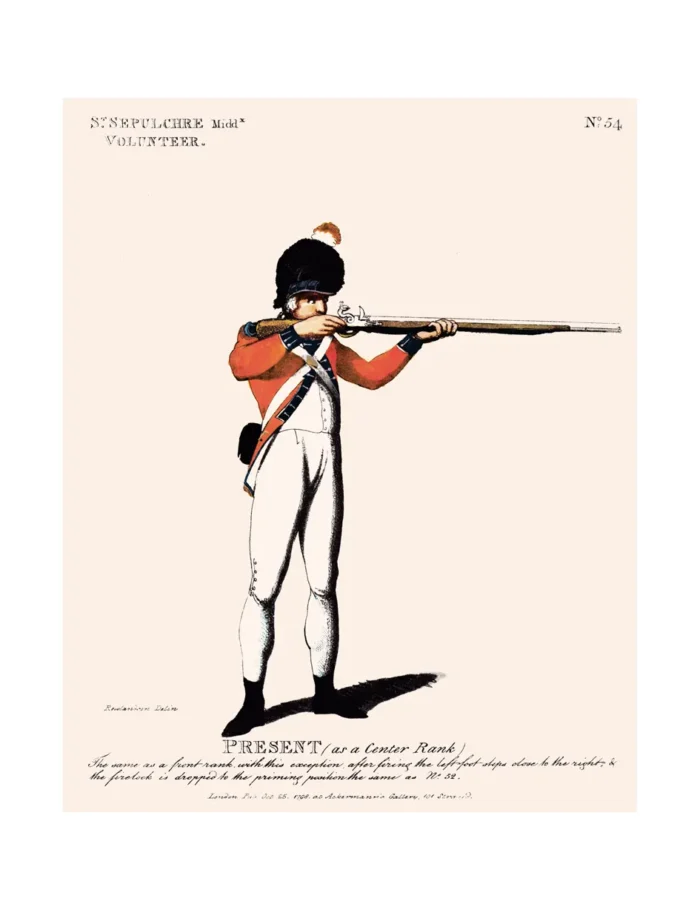No. 54 St. Sepulchre Volunteers
£12.00
Holy Sepulchre, London (scroll down for a more detailed Description)
The first reprints of the 1798 aquatints by Thomas Rowlandson (published by Rudolph Ackermann) published in 1972 by Hugh Evelyn Limited.
Image size is 20.5 x 25.5 cm [8” x 10”] against a light greyish orange background (c. RGB fcf2e1) impressed on medium high white matt cartridge paper of c. 120 g/m2.
Print size: c. 26.2 x 33.7 cm [17” x 12 ¾”] may vary slightly from printers’ cut 50 years ago
Details of London Wards and Parishes provided by © the British Library
We offer thanks to the Trustees of the British Library and British Museum and Wikipedia for some text (and map outlines
Print is STANDARD size – shipping is the same for 1 to 10 prints (based on largest print size in your order) – see Shipping & Returns
Who were the Loyal Volunteers ? See here
In stock
- Satisfaction Guaranteed
- No Hassle Refunds (see Shipping and returns)
- Secure Payments
Description

Holy Sepulchre London, formerly and in some official uses Saint Sepulchre-without-Newgate, is the largest Anglican parish church in the City of London. (See map – click to enlarge). It stands on the north side of Holborn Viaduct across a crossroads from the Old Bailey, and its parish takes in Smithfield Market. During medieval times, the site lay outside (“without”) the city wall, west of the Newgate.
It has London’s musicians’ chapel in which a book of remembrance sits and an October/November requiem takes place – unusual for a church associated with Low Church Evangelicalism. The church has two local army regiment memorials. The vicar is appointed by St John’s College, Oxford, which has held the church’s patronage since 1622.
The church is within the Newgate Street Conservation Area. The original (probably pre-Norman) church on the site was dedicated to St Edmund the King and Martyr. In 1137 it was given to the Priory of St Bartholomew. During the Crusades of that century the church was re-dedicated to Saint Edmund and the Holy Sepulchre, venerating the Church of the Holy Sepulchre in Jerusalem. Knights passed by on the way to the Holy Lands. This name became contracted, and in the 21st century reference to the saint-king has been overwhelmingly dropped. The very early lessening of the first dedication helped to reserve that name for the small church to the east of St Paul’s Cathedral dedicated to St Edmund, King and Martyr.
The church is today the largest parish church in the city. It was completely rebuilt in the 15th century but was gutted by the Great Fire of London in 1666, which left the outer walls, the tower and the porch standing. It was rebuilt 1667-1679 by Joshua Marshall the King’s Master Mason and appears to be remodelled to Marshall’s own design. Lightly modified in the 18th century, the interior of the church is a wide, roomy space with a coffered ceiling installed in 1834 with plasterwork of three years later. The church underwent considerable re-facing and alterations in 1878. During the Second World War the 18th-century watch-house, built in the churchyard to deter grave-robbers, was bomb-struck but later rebuilt. The vicarage was fully renovated in the early 2000’s. During Mary I‘s persecutions, in 1555, the incumbent vicar John Rogers was burned at the stake as a heretic.S.
Additional information
| Weight | 0.0121 kg |
|---|---|
| Dimensions | 25.5 × 32.5 cm |





